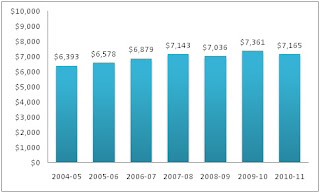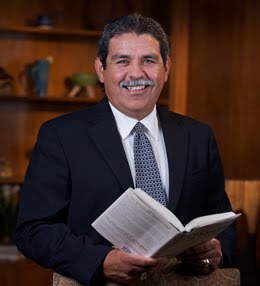
Heads government wins, tails you lose
Obama's capital gains tax increase (which will rise up to 23.9 percent) will not be indexed to inflation. This means you may very well pay taxes while losing money.
Why "Warnings of drastic cuts fall on public's deaf ears"
An unintentionally hilarious bit of analysis from the Las Vegas Sun on why the public isn't responding to the doomsday predictions of public officials.
The state budget director asked departments to prepare scenarios describing 10 percent spending cuts. And the state agency heads delivered their reports Sept. 1.Yep, David McGrath Schwartz, who wrote this piece, admits that government's been crying wolf and lying for the last three years about the impact of budget cuts - including all of those "we've cut to the bone" cries and, my all-time favorite bit of hyperbole, Jim Rogers threatening to blow his brains out if the NSHE budget cuts passed.
The governor's office won't release the documents, but agency heads describe the cuts as "ugly." Programs for the elderly and disabled will be eliminated. Hundreds of public employees will be laid off. About 3,000 prisoners will be released. School districts will go bankrupt.
But let's admit: You don't believe it.
After three years of budget-cutting and belt-tightening and predictions of pending bureaucratic catastrophes, the warnings have almost lost meaning.
Residents have heard the dire predictions before - at least four times during the state's previous rounds of budget cuts - and the doomsayers were wrong.
What's ironic is that while Schwartz details all of the reasons why Nevadans shouldn't trust government officials' doomsday predictions, he then appears to buy into a couple of government-approved reasons for why the public is skeptical - agencies haven't released their detailed budgets yet and that "agency heads, the governor's senior staff and legislators have avoided truly gruesome cuts." These reasons fall flat, however, because we've heard them before and, as Schwartz just detailed, they were lies.
Citizens aren't buying into government hyperbole for a variety of reasons. First, it's hyperbole. Second, these government officials and leftists are now known liars. Third, many Nevadans have had to make budget cuts of greater than 10 percent in their lives and businesses. Even the hyper-liberal Progressive Leadership Alliance of Nevada cut its budget by 20 percent when times got tough. It didn't kill PLAN, and it won't kill government. Fourth, and perhaps most importantly, government officials and bureaucrats still aren't being honest with the public.
Consider this sidebar from Schwartz's analysis: "Nevada's budget director has put the two year shortfall at $3 billion, and that's after several rounds of cuts in a state government that's among the nation's leanest by almost any measure. More cuts undoubtedly will be part of any budget-balancing package."
This statement is misleading. Andrew Clinger, Nevada's budget director, has put the state's two-year shortfall at $3 billion, but what neither Clinger nor Schwartz mentions is that the "$3 billion shortfall" figure contains a $1.5 billion spending increase. Seriously. Read this article and look at Clinger's e-mail for yourself.
Also unreported is that Nevada's state and local government tax collections are above the national average. Because Nevada is so decentralized, the state has intentionally delegated a lot of responsibility and tax dollars to local governments.
Until Nevada's politicians and government bureaucrats start being honest about Nevada's budget situation, the public will and should remain highly skeptical.
Update: Fixed a bad link.
Nevada unemployment rate hits record high, insert joke about failed stimulus here
Just another reminder that the Obama-Reid-Pelosi stimulus was and is an epic failure, especially here in Nevada.
The construction sector, restaurants and professional firms all added jobs in the month, but declines in Census jobs and other public-sector cuts offset that hiring to push statewide unemployment to an all-time high of 14.4 percent, the state Department of Employment, Training & Rehabilitation said this morning. That's up from 14.3 percent in July and 12.5 percent in August 2009.I think one thing that's often overlooked in discussing the unemployment rate in Nevada is the role our state's ever-increasing minimum wage has had on increasing unemployment.
Thanks to seasonal hiring among resorts and other employers, joblessness in Clark County edged down to 14.7 percent, from a record 14.8 percent in August. Unemployment in Las Vegas came in at 13 percent in the same month a year ago.
The employment department also emphasized the especially hard times younger workers are experiencing in the downturn. The jobless rate among workers 24 and under is nearly twice as high as overall unemployment.Bill Anderson, the chief economist for Nevada's Department of Employment, Training & Rehabilitation, attributes the high unemployment rate to older workers crowding out younger ones. No doubt this is a factor for some, but Nevada's high minimum wage is also pricing many unskilled workers out of the job market.
There's abundant national research [on the minimum wage] all right, but even liberal researches (who support increasing it) admit that increasing the minimum wage increases unemployment. And teenagers are increasingly feeling the effects of this misguided policy.Add even more bad news about unemployment in Nevada: Unemployment taxes on businesses are expected to increase by almost $1 billion.
License to describe
Yup, if you want to be a tour guide in Washington D.C. you need a license.
Happy Constitution Day!
Did you know/remember it was Constitution Day? Until yesterday, neither did I. Fortunately, the Heritage Foundation did and produced this terrific video.
Michelle Malkin has more.
The $3 billion deficit myth on the radio
Earlier this week, I wrote an article exposing the myth that Nevada is projected to have a $3 billion deficit. My main contention is that almost everything you've heard over the last six months about Nevada's projected budget deficit has been either wrong or seriously misconstrued to make the situation appear worse than it is.
If you're interested in this topic, I'm going to be on with Casey and Heather today at 10:15 am on 1280 AM KDOX to talk more about this issue. Be sure to tune in or listen live over the internet.
Muy bien Florida
Nevada should copy Florida's education reforms ASAP.
Budget cuts smudget cuts
Since the Clark County School District (CCSD) educates three out of every four Nevada children and spends $3 out of every $4 on K-12 education in the Silver State, examining its budget provides a reliable estimate for the overall health of spending in Nevada. So how are we doing in this economic downturn?
Since the massive, 2003 tax hikes began funding K-12 education in 2004, CCSD's total budget has increased 9.2 percent per pupil. The operating budget has increased by 9.8 percent and salaries and benefits for employees have increased by 12.1 percent. From the end of one recession to the end of another, CCSD has more money per pupil, even after adjusting for inflation. Hardly tough sledding.
So even with the "massive budget cuts" Nevada's K-12 education has seen in the last two years, Clark County's per pupil spending is still higher today than it was from the 2000-01 through 2005-06 school years.
Yet all we've heard from media reports and pundits (almost daily) for the last two years is that education has been "cut to the bone."
Since the recession began at the end of 2007, CCSD's per pupil spending from the general operating fund (yes, even adjusted for inflation to 2010 dollars) has declined by a "massive" 1.01 percent.
Yup, a 1 percent budget reduction - right down to the bone.
But as I've stated numerous times, the operating budget ($6,900 per pupil) isn't the total budget (which is $11,900 per pupil). CCSD's total budget per pupil has declined by an "impressive" 3.3 percent.
So are the children really suffering with a 1 percent decline in the operating budget and a 3.3 percent decline in the total budget? Hardly. It's the policymakers and bureaucrats who are "suffering" because they have to make adult decisions on how to use scarce resources more effectively.
Jobs for adults
"Staffing hurt by budget cuts" writes the Las Vegas Sun. Yes, that is true, in part. But when you take a close look at tax dollars devoted to salaries and benefits for K-12 education in Nevada, you'll notice that salary and benefits outstrips inflation and student enrollment growth combined - even within the last couple of years.
2004 was the first full school year in which the 2003 tax increases (then the largest in state history) were available to fund education. (It is also the first year with detailed data available for the Clark County School District's detailed budgets.) Since 2004, CCSD's general operating funding per pupil (what they consider the day-to-day operating budget for the school district) increased by 9.8 percent.
Salaries and benefits (per pupil) for CCSD employees grew by 12.1 percent - more than the operating budget and total budget.
This isn't surprising. After all, in 1955 the Clark County School District employed one person for every 20 students; today it employs one person for every 8 students. We have more employees in education earning far larger salaries and benefits. But is this investment producing the results we need?
Maybe it is time we start thinking about the outcomes for children rather than how many jobs K-12 education can provide for adults.
FYI, if you think 2004 is an arbitrary figure to select, those figures are higher than the spending for 2000, 2001, 2002 and 2003, with 2000 being the low point in the last decade. And if you are worried about the recent budget cuts, these increases INCLUDE the budget cuts. In fact, per pupil spending devoted to salary and benefits hasn't gone down AT ALL since the recession started.
Is Dallas Superintendent Michael Hinojosa a finalist to be CCSD Superintendent?
Last week NPRI's Karen Gray reported that during the super-secret search for the next Clark County School District Superintendent, Dallas Superintendent Michael Hinojosa was suggested as a prospect.
Now the Dallas Business Journal is reporting that Hinojosa is leaving his job in Dallas and tomorrow will be announced as a finalist for the CCSD job.
Three Dallas business and community leaders on Wednesday said DISD Superintendent Michael Hinojosa is set to announce Thursday that he is leaving his post. Meanwhile, a Las Vegas TV station has reported that Hinojosa could be named a finalist for the head of the Clark County School District at a meeting there Thursday.I admittedly don't know anything about Hinojosa, but this doesn't sound good.
Hinojosa was hired as DISD superintendent in 2005. The Dallas district has roughly 160,000 students and 20,000 employees, with an operating budget of more than $1.2 billion. It has struggled with finance and student performance issues.

 Read more
Read more




